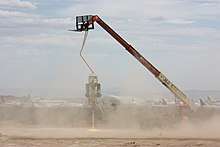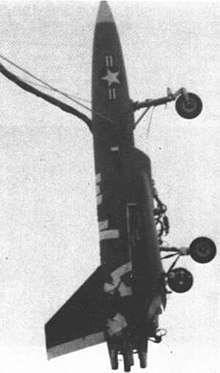Tethered flight test

Tethered rocket test

Tethered VTOL test
A tethered flight test is a type of flight testing where a machine is connected by a tether to the ground. Tethered testing may be used when motion through the atmosphere is not required to sustain flight, such as for airship;[1] VTOL, rotary wing or tiltwing aircraft (tethered hovering);[2] or for tests of certain rockets, such as vertical takeoff, vertical landing (VTVL). Fixed wing scale models can be tested on a tether in a wind tunnel, simulating motion through the atmosphere.[3]
References
- ↑ Botting, D.; Books, Time-Life (1980). The giant airships. Epic of flight. Time-Life Books. ISBN 978-0-8094-3272-1.
The first rigid airship ever to be flown was built in the 1890s with a skeleton and outer cover made of an exotic new metal: aluminum. The new ship, designed by David Schwarz, a Dalmatian timber merchant, lifted off successfully in a tethered test in Berlin on November 3, 1897...
- ↑ Cooke, A.; Fitzpatrick, E. (2009). Helicopter Test and Evaluation. AIAA Education. Wiley. p. 103. ISBN 978-1-4051-7254-7.
- ↑ Galison, P.; Roland, A. (2013). Atmospheric Flight in the Twentieth Century. Archimedes. Springer Netherlands. p. 81. ISBN 978-94-011-4379-0.
External links

This article is issued from
Wikipedia.
The text is licensed under Creative Commons - Attribution - Sharealike.
Additional terms may apply for the media files.